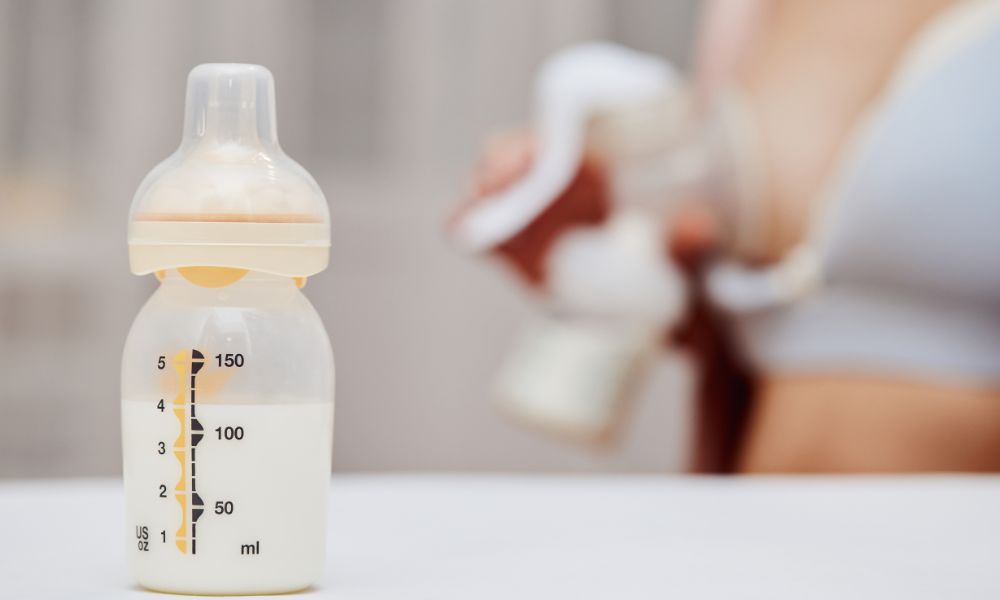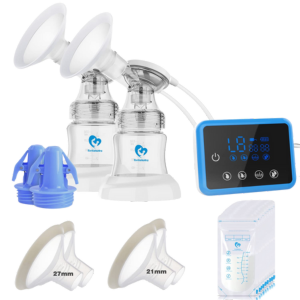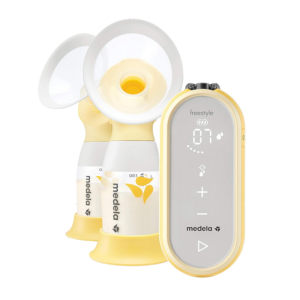A good breast pump can make pumping faster, easier, and more comfortable. Breast pump Making those early morning or mid-day sessions less disruptive and frustrating.
If you breastfeed your baby, you're probably aware of a breast pump. It can sometimes be helpful. Breast pumps are medical devices regulated by the Food and Drug Administration in the United States. They can maintain or increase a woman's milk supply. And also relieves full breasts. And help insert milk ducts, pull-out flats, or inverted nipples to make it easier for a nursing baby to latch on.
What Types of Breast Pumps Are Present?
Breast pumps are made up of three parts:
- A breast shield that fits on top of the nipple,
- A pump that produces a vacuum to express (or pump) milk and
- A removable container for collecting milk.
Pumps can be powered or manual. Pumps powered by batteries or a cord fitting into an electrical outlet are available. Some pumps even include an adapter for use in vehicles. (Of course, not while you're driving!)
Single pumps extract milk from one breast at a time, whereas double pumps take milk from both breasts simultaneously.
Is Sharing A Breast Pump Safe?

If the pumps are not designed for multiple users, renting or sharing them can be dangerous.
Consumers should be aware of the risks of renting or sharing a breast pump. It is not intended for multiple users, even with family and friends. Infections from contaminated breast pumps could affect both you and your baby. Key consider breast pump safety:
- Manual breast pumps are intended for single use only. And should never be rented or shared for your safety reasons.
- Powered breast pumps meant for a single user should never be shared.
- Sharing a breast pump may void the manufacturer's warranty, which means you may be unable to obtain help from the manufacturer if there is a problem with the pump.
- Because the FDA does not recognize the term "hospital grade," it does not imply that a pump is safe.
What is the final word on sharing breast pumps designed for single users? Don't try it.
Multiple-user pumps are created so that breast milk never comes into contact with the pump's shared working parts. The pump is the only part of a multiple-user breast pump system you can safely share.
What Type Of Breast Pump Should You Buy?
Consider your requirements before buying a pump. For example, a plug-in model may suffice if you only intend to use the pump at home. If you'll be pumping at work or elsewhere away from home. You may want to consider a device that's portable and battery-powered. When you buying a breast pump for your baby, you should need the following considerations:
- Never buy a previously used or "pre-owned" breast pump. This is because used pumps can expose you and your baby to contamination.
- Purchasing a used pump could void the manufacturer's warranty.
- If you're unsure about which pump or accessories to buy, consult a healthcare professional specializing in breastfeeding.
How Should A Breast Pump Be Cleaned?
Contamination can occur even in your personal pump if it needs to be cleaned correctly. Correct use and cleaning protect both you and your child.
The FDA suggests cleaning and disinfecting after each use. For particular guidance on how to keep your pump clean, consult the manufacturer's instructions... In general, cleaning step are the following:
- After pumping, rinse each piece that comes into contact with the breast milk in refreshing water as soon as possible.
- Using liquid dishwashing soap and warm water, wash each piece separately.
- Using hot water, thoroughly rinse each piece for 10 to 15 seconds and
- Allowing the pieces to air dry on a clean paper towel or in a clean drying rack.
Wiping the pump body with 70% to 90% ethanol or isopropyl alcohol or boiling the breast pump parts in water is also acceptable. Stop using the tubing immediately if it appears to be moldy or cloudy.
If you're renting or buying a multi-user device, ensure all components (including internal tubing) have been cleaned and disinfected according to the manufacturer's instructions.
1. Best Double-Electric (TIE): Spectra S1 Plus Hospital Strength Breast Pump

The Spectra S1 Plus is frequently cited as the favorite of moms and lactation consultants in the 'electric pumps' category. Not surprising, given that it's a whisper-quiet, lightweight (only 3 lbs.), yet powerful machine with suction power of up to 12 levels (270 mmHg)! We especially like the small number of parts (for easy cleaning), rechargeable battery, and useful extras like a nightlight, built-in timer, and memory function that saves your previous settings.
Pros
- Very powerful
- Efficient
- Easy to use
- Closed system
Cons
- Short tubes
- A bit heavy
2. Best Double-Electric Breast Pump (Tie): Medela Pump in Style with MaxFlow Breast Pump

Look no further than the best-selling Medela Pump in Style with MaxFlow for a hospital-grade breast pump. This high-performance breast pump. Features a modern motor vacuum for producing milk. It is so efficient and simple to use that it eliminates the guesswork from pumping! It's clinically proven to increase milk volume by 11.8% (based on data on file comparing Personal Fit Plus to Personal Fit). And it comes with a stylish cooler bag.
Pros
- Portable battery pack
- Carrying case included
- Very easy to use
Cons
- A bit loud
3. Best Budget-Friendly Double-Electric Breast Pump: BellaBaby Double Electric Breast Pump

We're all about saving money on baby gear, but sometimes spending less results in less. Fortunately, the BellaBaby Double Electric Breast Pump is not one of them. This opens a new window. You can use this breast pump as your primary or backup pump. And eliminate the need to lug one downstairs or to the office daily.
This small and lightweight pump has two pumping modes and multiple suction levels. The pump itself is also stylish. The device, which is small enough to fit in the palm of your hand, clearly displays the operating mode and suction level.
One of the most appealing aspects of this low-cost pump. It can be used wirelessly. It is battery-powered and can operate for up to 100 minutes without recharging. As a result, if you pump while doing something else, the battery is less likely to die in the middle of your session.
It's worth noting that while there are different suction levels, even the lowest setting is compelling perhaps even a little too powerful, according to some parents who complain of nipple tenderness.
Pros
- Under $100
- Easy-to-operate
- Good battery life
- Compact and lightweight
Cons
- A bit loud
- Some moms say suction is too strong
4. The Best Traveling Breast Pump: Medela Flex Freestyle

The Medela Freestyle Flex Opens a new window is similar to the Medela Pump in Style with MaxFlow pump. It is a dual-electric pump that mimics a baby's natural sucking pattern. How does it differ? Size. This is one of the markets lightest and smallest breast pumps, weighing less than a pound (it looks like an oversized mobile phone). So, if you'll be carrying it around the house, on a trip, or to and from work, the Medela Freestyle Flex could be a good choice.
The rechargeable battery lasts about two hours (quite impressive for a battery-powered pump!). The device has Bluetooth connectivity, allowing you to control your pumping session. And monitor your output via the Medela app. It also includes a USB charging cable, ideal for use in the car or other places where you may not have access to a regular outlet.
It's also simple to use (only four buttons) and stylish with a back-lit digital screen that shows information like suction level. And a timer (so you may pump in a dark room while your baby sleeps).
Pros
- Compact
- Lightweight
- Good battery life
- Easy to use
Cons
- A little expensive
5. Best Custom-Fit Breast Pump: Evenflo Feeding Deluxe Advanced Double Electric Breast Pump

The majority of breast pumps are one-size-fits-all. Yes, you can change flanges on some to better fit your needs. However, this involves some trial and error, which can waste time and money. Take a look at the Evenflo Feeding Deluxe Advanced. This opens a new window. This double-electric pump eliminates uncertainty by including multiple flanges with your initial purchase. If you haven't found one that works for you, there are more options available separately.
It also has numerous speed and suction settings, as well as a closed system that protects milk from mold and bacteria growth. This version improves on its basic previous version in several ways, including being 50% quieter and 30% lighter (weighing less than a water bottle), as well as including the brand's Balance + bottle nipple and lactation consultant support.
Pros
- Closed-system
- Lightweight
- Comes with three different flanges
- A wide range of speed and suction settings
Cons
- Doesn’t work with most standard pumping bras
- Suction is not quite as strong.
Breastfeeding is highly recommended for new mothers due to its numerous benefits to both the mother and the child. Some mothers, however, may have difficulty breastfeeding their babies due to factors such as health conditions or work commitments. Breast pumps, in such cases, provide an effective solution by allowing mothers to express milk and store it for later use.
Breast pumps have grown in popularity worldwide as more women want to balance their professional and personal lives while still providing optimal nutrition to their babies. With so many types of breast pumps on the market today. It can be challenging for many new mothers to choose the right one.

